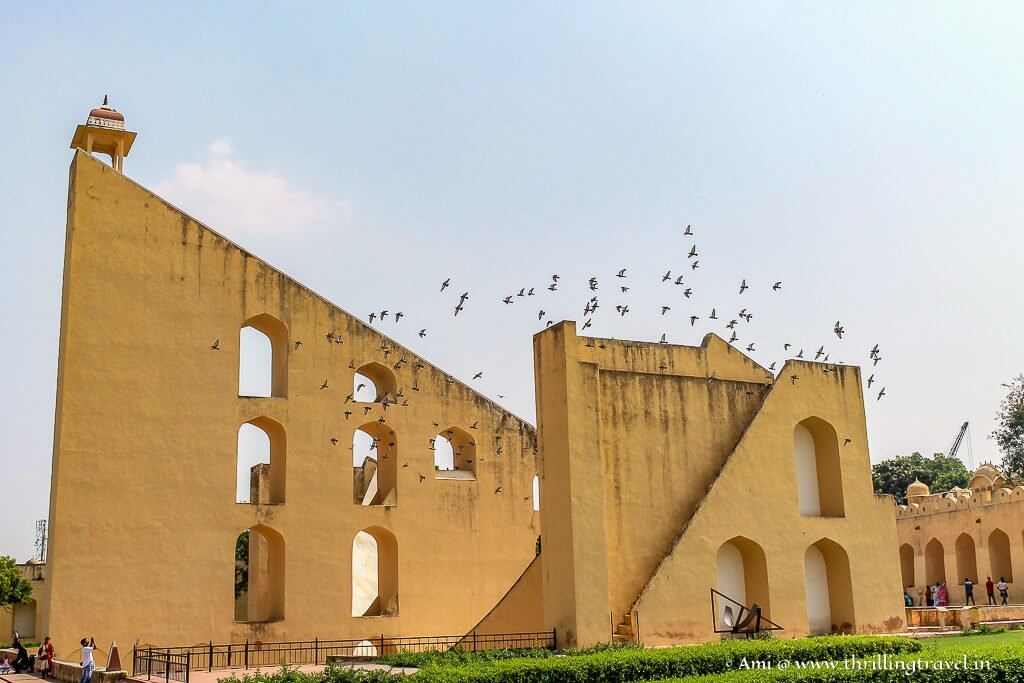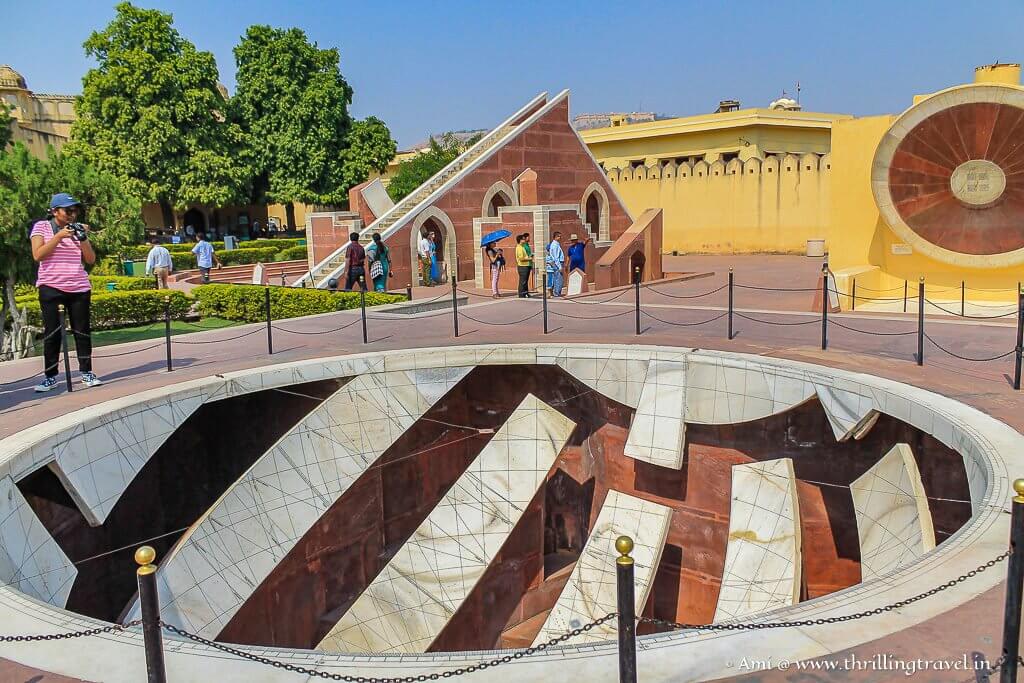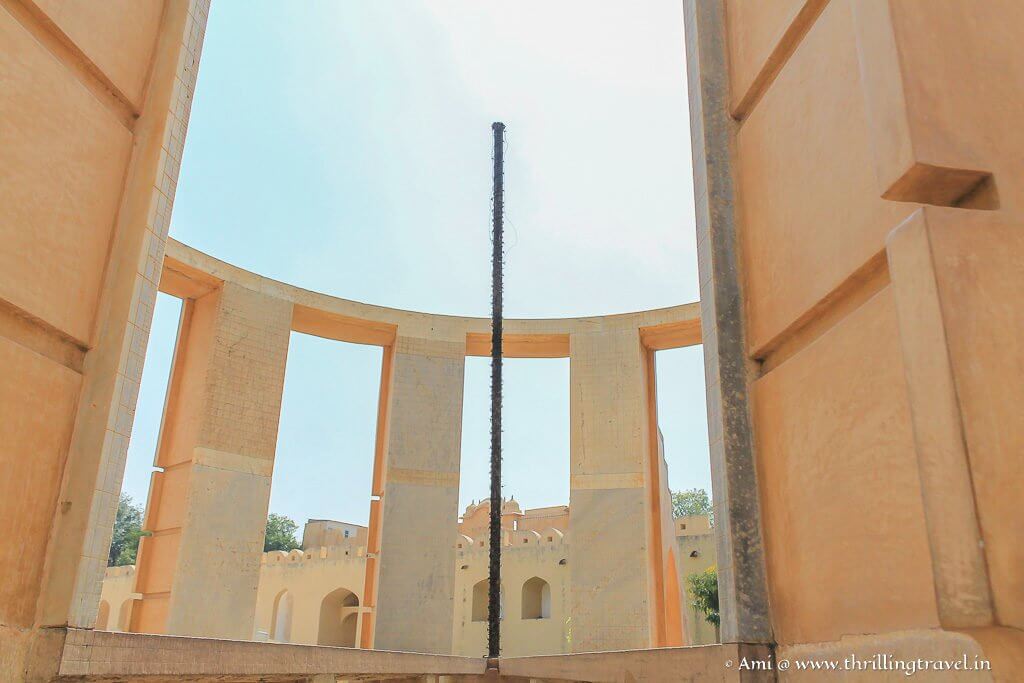There is enough said about how fascinating it is to visit the Jantar Mantar in Jaipur but nothing prepared me for the absolutely amazing and awe-filled experience that this UNESCO World Heritage site offered. Amazing – for the instruments still work with absolute precision and awe for the science and knowledge that went into building this centuries ago. So here is me, sharing this thrilling experience of Jantar Mantar with you.

Contents
What is the Jantar Mantar in Jaipur?
Jantar is derived from the word that means instruments while Mantar means formula. Jantar Mantar is an ancient scientific astronomical observatory which relies on the movement of the Sun and celestial bodies to predict the time, astronomical calendars and lunar charts. Built by Maharaja Jai Singh II, this heritage site consists of 5 major instruments that were used by the royal astrologers and time-keepers. The precision with which these instruments were made makes you wonder how advanced and learned was the civilization back then – so much so that even with our modern timekeeping, you cannot refute the accuracy of these instruments. So, sit upright and let’s go through these instruments to understand why I am so awe-struck. I am pretty sure that by the end of this post, you will be adding this to your list of things to do in Rajasthan.
History of Jantar Mantar Jaipur
If you ask someone where it the Jantar Mantar in India, you will get varied answers. Some might say Delhi, maybe Mathura or Varanasi. None of these are wrong for Maharaja Jai Singh constructed five Jantar Mantars in India. They are spread over Delhi, Jaipur, Mathura, Varanasi, and Ujjain. Though the one in Delhi is the oldest one, it is the Jaipur Jantar Mantar in Rajasthan that is the most elaborate. The Ujjain and Varanasi ones are smaller and you can still see. Unfortunately, the Mathura one got destroyed in the 1857 revolt.

All the Jantar Mantar were built between 1724 to 1738. Owing to the tumultuous political environment in India, the Maharaja felt the need to consult astrologers. He built the observatory not just to tell time but largely to check the planetary positions so that he could get some accurate predictions. Post his death, his successors used the same with varying level of importance. His successor in 1835 – Maharaja Ram Singh enhanced the instruments, increasing its longevity and accuracy. Unfortunately, later the whole site was neglected. It was Maharaja Sawai Madho Singh II who revived and restored it in the 1900s. It is amazing how this 18th-century timepiece has survived time to still give you the exact moment of the day!
The Five Key Instruments of Jantar Mantar
Well, if you get down to counting, there are actually 19 instruments. However, for the sake of simplicity, I have put them together are five major sets. The reason why I club a few together is that they are actually dependent on each other. How, What and Why will be pretty clear once you go through the rest of my post. For now, here is the list of the five key instruments of Jantar Mantar –
- Samrat Yantra
- Jai Prakash Yantra
- Rashivalyas Yantra
- Yantra Raj
- Ram Yantra
1) Samrat Yantra – the solar clock

This instrument gives you the time of the day based on the shadow formed by the sun. There are actually two of these at the Jantar Mantar in Jaipur. The smaller one is called Laghu Samrat Yantra while the bigger one is referred to as Vrihat Samrat Yantra. Both of these still work. The curved marble surface is marked with lines denoting hours, minutes and degrees. The shadow of the center projected line falls on the right-hand marble slab in the first half of the day and post noon, shifts to the other side. The center is at right angles to the ground and is generally termed as the gnomon.
Now prepare to be amazed. The time units on this are well marked with the main large marking being the hour, which is further divided into 15 minutes. Each of the 15 minutes is calibrated into five minutes, further broken to minutes and then 20 seconds.

At the time I took this picture, the shadow was on 11:34. On that day, with the Sun’s position, we needed to add 12 minutes to our time, giving us the time of 11.46. And guess what????? That was exactly, the time on our wristwatch. To add further proof, the picture that you see here has recorded the same time in its camera properties. Mindblowing, right?
The time correction in minutes changes by the day and is generally displayed on a board at the entrance. To discover this magic on your own, remember to take a note of this time correction.

The Large Samrat Yantra, also called Vrihat Samrat Yantra, is the biggest Sundial in the world and is the centerpiece of the Jantar Mantar in Jaipur. It is over 27 meters in height and works on the same principle as its smaller model, except that this is even more accurate, to a point of 2 seconds as against the smaller Samrat Yantra where the smallest division on its scale at 20 seconds. The center of the gnomon is a flight of steps that lead right up to the highest point of this observatory.
It is said that in the olden days, during Guru Purnima, the Royal astrologers would climb up and hang a white flag. Based on the winds and the incline of the Sun, they would predict the monsoons that year. I would have loved to climb and take a view from atop- and yes, capture it for you – but sadly, it is not allowed.:-(
2) Jai Prakash Yantra – guess the zodiac month

Imagine the Earth cut into two hemispheres and each hemisphere is set into a depression. This is exactly how this instrument looks. The hemisphere is marked with some lines representing latitude and longitude of the Earth, along with the zodiac signs on it. There is a small metal sheet suspended over it with a set of wires. Based on the Sun’s position, the metal sheet casts a shadow on the depression. Wherever the shadow appears, it indicates the zodiac sign at that point in time. The other markings are read for further calculations of auspicious and inauspicious moments.
I visited this on the 18th of October, and well, guess where the Sun cast its Shadow? Clue: Linda Goodman would have been proven right!
3) Rashivalyas Yantra – the zodiac machine
This is a set of 12 instruments- each one representing a zodiac sign or Rashi. The manner in which they are placed and angled had been calculated to ensure that the Sun’s rays fall only on one instrument, where it would cast a shadow- indicating the Sun Sign at that time of the year.

Based on the zodiac month indicated by the Jai Prakash Yantra, the Royal astrologers approached only that zodiac instrument in the Rashivalyas Yantra to calculate the exact angle of the stars and the Sun on a particular day and time. The arcs of the instrument were calibrated with marks that represent the angle of that Zodiac constellation in the sky.

Note the Shadow formed in the picture. This was used as a pointer to the angle that was duly noted down by the Royal astrologers for their horoscopes.
4) Yantra Raj – know where your stars are aligned

These are a set of metal discs- now hung separately but could be used one over the other. The entire disc is marked with various planets on a circle. Here is a close up of the marking on the disc.

If you notice, there is a small hole in the center of the plate. This is where a telescopic pipe was inserted. Based on the angle of the constellation, which was determined by the Rashivalyas Yantra, the disc was rotated to that angle and the planetary conditions were observed in the night sky to see their alignment for the lunar calendars and horoscopes. A further deep-dive into the celestial objects within the zodiac constellation.
5) Ram Yantra – how high is the Sun today?
Ram Yantra is a set of 2 complimentary models as seen in the picture above. Don’t they resemble the Stonehenge? 😉

Inside the instrument is a long perpendicular rod at the center while around the same are circular discs calibrated with markings. Depending on the shadow cast by the sun on these markings, one could figure the altitude of the Sun. The instrument gives you a direct reading of the same. Fascinating right?

And if you did not want to get into such complicated calculations, all you have to do is head to the simplest instrument called the Narivalya Yantra – a simple dial – one side of it for the Winters and one for the Summers.

This behaves like a normal clock that we are used to, wherein the needle formed by the shadow of the iron rod in the center, falls on the time.
What is amazing is that these instruments are still accurate. Imagine the science and math that went into getting them up. Just so that they were constructed accurately and the design was not lost in any war or natural disaster, they were actually prototyped and tested. The small models of each of these major instruments can still be seen on the premises.
So, if you are planning a Rajasthan tour, you must definitely add Jantar Mantar in your list of things to do in Jaipur. Your trip to this pink city would be incomplete without it.

How to get to Jantar Mantar in Jaipur?
- Jaipur is a major city of India. It has excellent connectivity by road, rail and flight. There are plenty of international cities that are linked by regular flights to Jaipur.
- Jantar Mantar is quite accessible and central to Jaipur. You can either hire a Tuk Tuk or Rickshaw to reach the same. There are several local buses that will drop you here too. Click here to get it on your Google Maps.
Where to stay in Jaipur?
- Being a major city, Jaipur has a plethora of stay options. From posh Jaipur Hotels to pretty havelis and home-stays. You can book any of these online.
- To understand which area you need to book these hotels, refer to this post of mine on best areas for Hotels in Jaipur.
Travel Tips:
- Check out my general travel tips for Rajasthan here. Do make a note of my suggestions on hiring guides and local transport.
- The approved guide charges are displayed at the Entrance. There is an audio guide available in English, French, Spanish and Chinese.
- The adult ticket to Jantar Mantar costs you INR 55 if you are Indian and INR 200 if you are a foreign national. Students and Children are at concessional rates.
- Taking a composite ticket that allows you access to 5 – 6 other monuments like the Hawa Mahal, Amer Fort, City Palace, Nahargarh Fort, Jaigarh, Sisodia Gardens and Albert Hall over the next two days. This would cost you INR 300 if you are an Indian or INR 1000 if you are a foreign national. This is easily do-able if you follow this 3-day itinerary for Jaipur.
- Cameras are charged extra.
- Jantar Mantar is open from 9 am to 5 pm on all days.
Disclaimer: This article includes affiliate links. This means that at no cost to you, I will receive a small commission if you purchase through my link. Thank you for supporting me with this.

Popularly referred to as a Restless Ball of Energy. My Mom refuses to entertain my complaints about my equally restless daughter & assures my husband that I was born with a travel bug.
I am a Post-Graduate in Marketing by qualification and a travel blogger by passion. Besides travel, I enjoy photography and if you don’t find me at my desk, I would be out playing badminton or swimming or just running. I believe in planning for every long weekend through the year. And when I cannot travel physically, I travel virtually through this travel blog. My travel stories have also, got published on various websites and magazines including BBC Travel, Lonely Planet India and Jetwings. I have recently published my first book – When Places Come Alive – a collection of stories that are based on legends, landscapes, art and culture of a place which is available in both ebook and paperback format.

Very elaborate post! I had been there and really enjoyed the place. It amazed me the kind of development was present then.
Thanks for the detailed post.
I have been there but it still feels new when I read your post! I wonder why I forget all the historic details 🙁
I feel the same too Archana . 🙂
Thanks Indrani. The ancient science amazed me too
Thanks Arun
🙂 Am glad I could refresh them for you. 🙂
I had been to Jantar Mantar April 2012,wow your presentation is awesome!! It feels as if one is present there 🙂
Thanks Monika….I felt as if i was re-living my trip as I wrote this blog post
🙂 always the case with all travelers. Time never seems enough.
This is one of the coolest places I’ve seen, and it’s so weird/sciency. I love it.
Absolutely and imagine…they had it so many years back and it still works
Have been to the one in Delhi, need to visit here as well.
I am sure you will love this one. I am told that this one is more accurate than the Delhi one.
Wow- I was amazed when I went to Greenwich! This is just fascinating. If I ever get anywhere close I am going!
I am sure you will love it. The ancient technology still works so well.
Super cool! Thanks for the great detail.
🙂 Thanks
This is so cool! I am absolutely amazed with how advanced civilization was so long ago.
Yes, it is truly fascinating and more so coz a lot of it still works now
well done
Thank you 😀
Jantar mantar is my favorite tourist site in Jaipur. Isn’t it amazing how accurate the system was 300 years ago?
I am absolutely amazed at the technology then. It sure is fascinating
Ami, I will like to say that you have shared a really best blog regarding jaipur with all of us.
Thank you so much. That is such a high praise
I am going to say that I really like all of these places which images had shared here.
Thanks Hogward
the large Samrat Yantra is quite a sight! I’ve never been to Jaipur but I will have to one day. I’ve been to Greenwich, being close to me, but that is the extent to what I have seen in relation to this.
You will find this tuned to the Greenwich meantime – goes to show how fascinating the ancient technology was 😀
Very detailed post on the Mantar and it does look like an interesting building, I dont think I seen anything like this before on the road. Love the way it is connected to the stars, sun and zodiac.
Ancient science that was so well developed that even today we use it 😀
Love the color of all the buildings — so photogenic! And how fascinating that the science behind this installation still works and has been preserved so well.
The instruments are actually timeless 😀
What a cool place to visit, I’m adding this to my bucket list. I love how the buildings were designed to resemble astrological instruments.
They don’t resemble but accurately pinpoint your zodiac 😀
It’s amazing how advanced astronomy was in the 1700s. To read the accuracy you observed with the solar clock is quite fascinating. Great detailed article and great to read about these astrological instruments.
Thanks Rosemary. It is indeed fascinating to see how accurate they have got the time here.
I recently watched a video about Jaipur but it didn’t give any information about Jantar Manta. I am glad I came across this post. I would like to Visit Jaipur when I go to India
This is unmissable if you are in Jaipur. Glad you found it in time
Most comprehensive post on Jantar Mantar yet. Kudos! I also appreciate the way the authorities have maintained the instruments even after almost 3 centuries.
Indeed…it is commendable that the place is so well maintained and still in a working condition
Jantar Mantar Is so cool! I didn’t know about this but I love buildings that were made with a scientific purpose like this. I know some of the Mayan Areas I visited in Mexico were built for similar reasons. Fascinating.
I would love to compare the Mayan ones with this one. Bet they had a similar technology then.
Was fascinating with the depth of information that your post gives on the world’s biggest sundial. Few people would be aware that it is made so intricately. The pictures are lovely too…every detail is clearly visible.
Thanks Punita. It is fascinating when you see it all work and so, accurately!
Wow! The architecture blew my mind! It’s amazing that this place would literally teach how to know yourself even more! The science and math combined together to how they engineered this building in a detailed way – is an absolute genius and no wonder it’s in the UNESCO World Heritage. Lovely photos! I wanted to take a flight there tomorrow and know all the science about me!
Trust me Katrina. You are bound to love it here. Hope you get to Jaipur soon.